
Mark Twain Book Covers and Illustrations
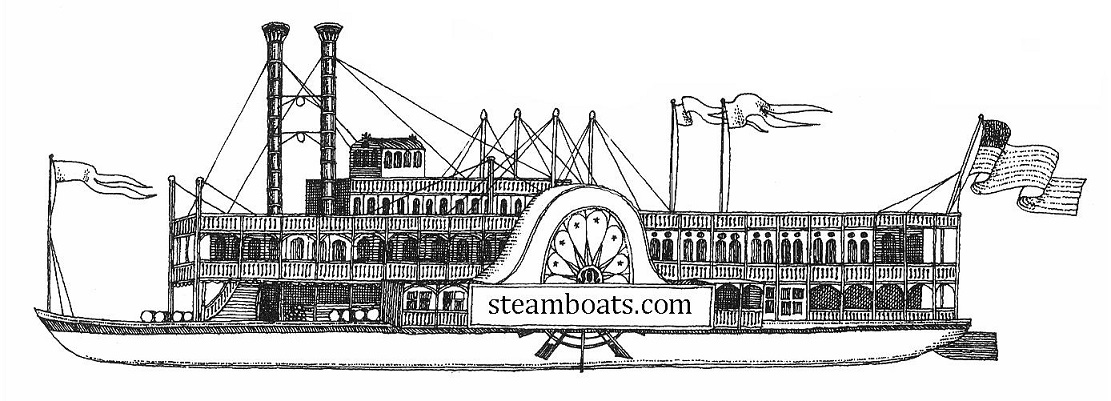
One of Klaus Ensikat's illustrations for Mark Twain's LIFE ON THE MISSISSIPPI. (With name of this website added!)
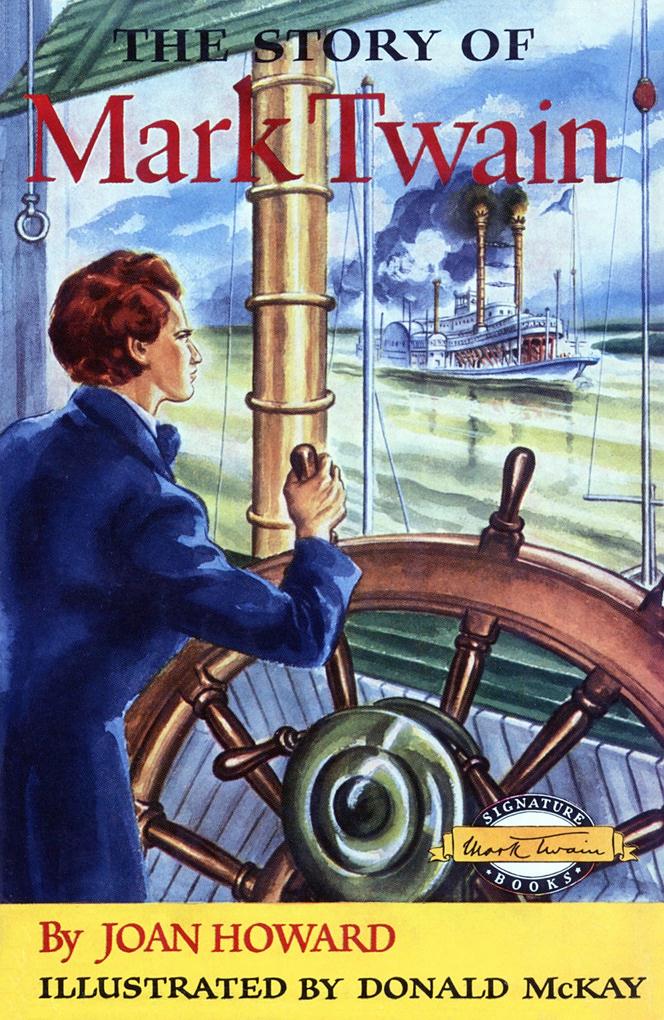
Dean Cornwell's ROB'T E. LEE (from the race with the NATCHEZ painting) was referenced by illustrator Donald McKay for his 1953 dust jacket watercolor in which the young steamboat pilot Sam Clemens is at the pilot wheel in the foreground and big sidewheeler is visible in the distance for THE STORY OF MARK TWAIN which was from the Signature Book series of biographies for juvenile readers, this one written by Joan Howard and it was published by Grosset & Dunlap, NY 1953. McKay had previously illustrated both of Twain's Tom and Huck novels and also a short novelette by Irwin Shapiro called STEAMBOAT BILL and the CAPTAIN's STRAW HAT about the hero of the song "Steamboat Bill" and in the novelette Mark Twain appears as a character. The book was published by Julian Messner, Inc. NY. 1943

TWAIN & STANLEY ENTER PARADISE
Preview of this book here: Google Books A final novel by the late Pulitzer Prize-winning author of The Mambo Kings Play Songs of Love is inspired by the friendship between 19th-century journalist-explorer Henry Stanley and Mark Twain throughout a journey to Cuba in search of Stanley's father.
TWAIN & STANLEY ENTER PARADISE, by Pulitzer Prize-winning author Oscar Hijuelos, is a luminous work of fiction inspired by the real-life, 37-year friendship between two towering figures of the late nineteenth century, famed writer and humorist Mark Twain and legendary explorer Sir Henry Morton Stanley.
Hijuelos was fascinated by the Twain-Stanley connection and eventually began researching and writing a novel that used the scant historical record of their relationship as a starting point for a more detailed fictional account. It was a labor of love for Hijuelos, who worked on the project for more than ten years, publishing other novels along the way but always returning to Twain and Stanley; indeed, he was still revising the manuscript the day before his sudden passing in 2013.
The resulting novel is a richly woven tapestry of people and events that is unique among the author's works, both in theme and structure. Hijuelos ingeniously blends correspondence, memoir, and third-person omniscience to explore the intersection of these Victorian giants in a long vanished world.
From their early days as journalists in the American West, to their admiration and support of each other's writing, their mutual hatred of slavery, their social life together in the dazzling literary circles of the period, and even a mysterious journey to Cuba to search for Stanley's adoptive father, TWAIN & STANLEY ENTER PARADISE superbly channels two vibrant but very different figures. It is also a study of Twain's complex bond with Mrs. Stanley, the bohemian portrait artist Dorothy Tennant, who introduces Twain and his wife to the world of s´ances and mediums after the tragic death of their daughter.
A compelling and deeply felt historical fantasia that utilizes the full range of Hijuelos' gifts, TWAIN & STANLEY ENTER PARADISE stands as an unforgettable coda to a brilliant writing career.
A New York Times "Editor's Choice"
A Vanity Fair "Best Book for History Buffs"
A Boston Globe Fall 2015 Pick
One of Newsday's "20 Best Books to Read this Fall"
One of Men's Journal's "7 Best Books of November"
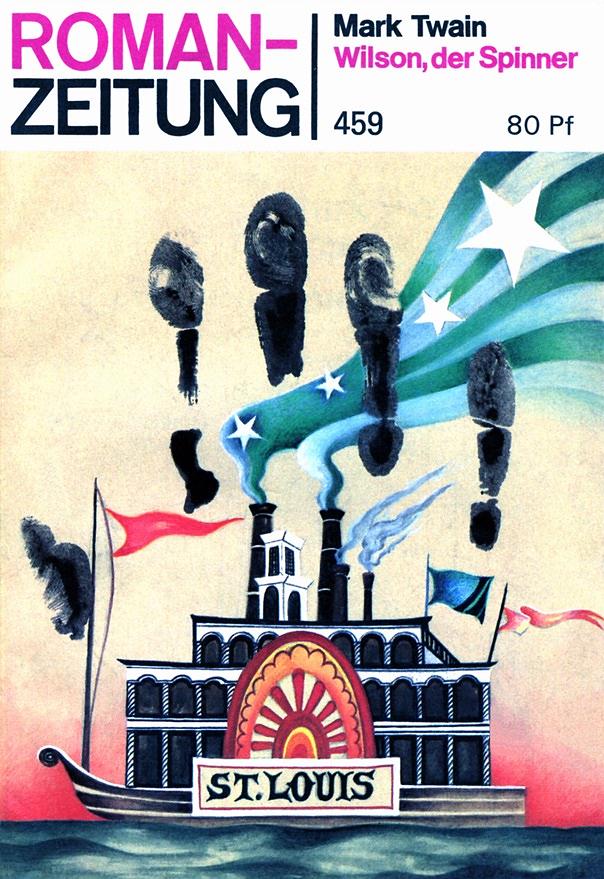
Stylized steamboat on cover of 1988 German edition of PUDD'NHEAD WILSON
Stylized steamboat on front cover of PUDD'NHEAD WILSON by Sam Clemens (Mark Twain) published originally in 1893-94 but this time in a 1988 German soft cover edition translated as WILSON, DER SPINNER (The "spinner" in this case translates as "odd ball" or "screwball" in German).
Superimposed above the steamboat is a hand print, probably from the thumb and fingers of the hand of the artist who created this painting above the fantasized steamboat St. LOUIS that has 4 stars manifested in the smoke coming from the stacks. In this novel Clemens pioneered the device of employing fingerprints to solve a murder mystery and also the identity of 2 babies who had been switched at birth by their nurse. The story begins in 1830 in the river town of Dawson's Landing, Missouri, half a day's journey south of St. Louis by steamboat on the Mississippi River.
(Berlin), Volk u. Welt, 1988. Lizenzausg. v. Neues Leben
A reprint of a 1986 edition erstmals in dieser Übers. Übers. a.d. Amerik. v. Reinhild Böhnke.
M. Autorenfoto u. Kurzbiographie. 109 zweispalt. bedruckte S.
Illustr. OKart. (v. Angelika Rößler)
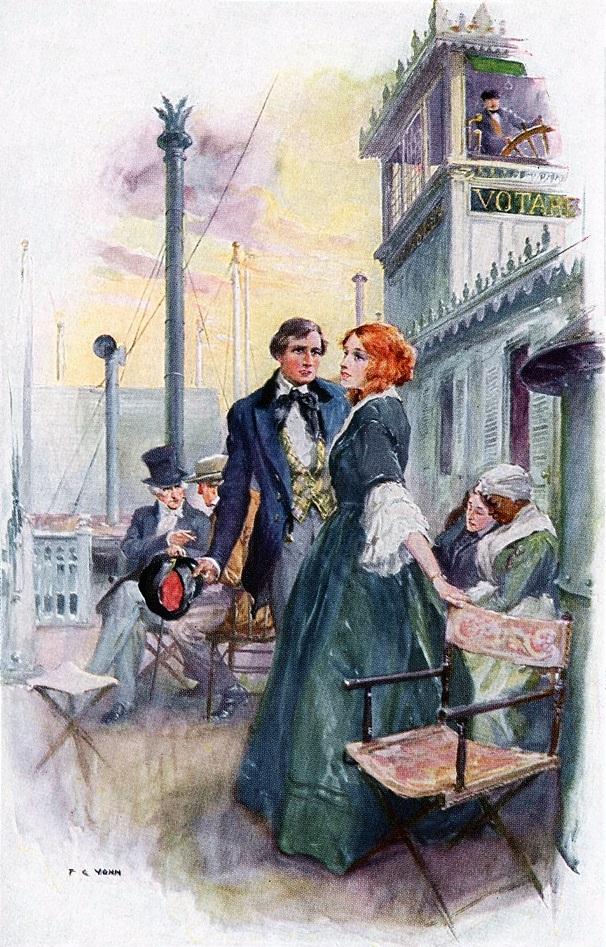
George Washington Cable was a prominent Louisiana writer who wrote fact and fiction about New Orleans and all classes of Southern society, most notably the Creoles. Cable and Mark Twain went on a lecture tour together in the U.S. together during late 1884 and 1885.
Cable's 1914 Mississippi steamboat novel GIDEON's BAND was illustrated by Frederick C. Yohn who illustrated other steamboat stories in periodicals and many paintings of scenes of the American Revolution including, his best known work was of Washington at Valley Forge.
Attached one of Yohn's beautiful illustrations for Cable's novel, this one set on the upper deck of the fictional steamboat "Votaress" with pilot house, starboard 'scape pipe, paddle box, "Texas" cabin and a part of the lower portion of the starboard smokestack. The colorful costumes of the six characters accurately evoke the flavor of that antebellum Southern world.
Below is text that I abridged from the first two chapters of the novel.
GIDEON'S BAND
A Tale of the Mississippi
by George Washington Cable (1844-1925)
ILLUSTRATED BY
F. C. YOHN
[Frederick Coffay Yohn] (1875 - 1933), NEW YORK
CHARLES SCRIBNER'S SONS 1914
I THE STEAMBOAT LEVEE
Saturday, April, 1852.
New Orleans, Louisiana . . . the Mississippi River
. . . this great sun-swept, wind-swept, rain-swept, unswept steamboat levee.
. . . along that mile-wide front . . . there were a hundred river steamers . . . you would behold with one sweep of the eye.
. . . letting themselves be unloaded and reloaded, stood the compacted, motionless, elephantine phalanx of the boats.
. . . their low, light-draught hulls, with the freight decks that covered them doubled in carrying room by their widely overhanging freight guards, were hid by the wilderness of goods on shore.
Hid also were their furnaces, boilers, and engines on the same deck, sharing it with the cargo.
But all their gay upper works, so toplofty and frail, showed a gleaming white front to the western sun.
You marked each one's jack-staff, that rose mast high from the unseen prow, and behind it the boiler deck, high over the boilers.
Over the boiler deck was the hurricane roof, above that the officers' rooms, called the "texas."
Above the texas was the pilot-house, and on either side, well forward of the pilot-house and towering abreast of each other and above all else—higher than the two soaring derrick posts at the two forward corners of the passenger and hurricane decks, higher even than the jack-staff's peak—stood the two great black chimneys.
. . . More than half the boats, this April afternoon, flew from the jack-staff of each, to signify that it was her day to leave, a streaming burgee bearing her name.
A big-lettered strip of canvas drawn along the front guards of her hurricane-deck told for what port she was "up," and the growing smoke that swelled from her chimneys showed that five was her time to back out.
In the midst of the scene . . . lay a boat which specially belongs to this narrative.
A pictorial poster, down in every café and hotel rotunda of the town, called her "large, new, and elegant," and such she was in fair comparison with all the craft on all the sixteen thousand navigable miles of the vast river and its tributaries.
Her goal was Louisville, more than thirteen hundred miles away. Her steam was up, a velvet-black pitch-pine smoke billowed from her chimneys, and her red-and-white burgee, gleaming upon it, named her the Votaress.
II THE "VOTARESS"
Her first up-river trip!
The crowd waiting on the wharf's apron to see her go was larger and included better types of the people than usual, for the Votaress was the latest of the Courteney fleet, hence a rival of the Hayle boats, the most interesting fact that could be stated of anything afloat on Western waters.
So young was she, this Votaress, so bridally fresh from her Indiana and Kentucky shipyards, that the big new bell in the mid-front of her hurricane roof shone in the low sunlight like a wedding jewel.
Its parting strokes had sounded once but would sound twice again before she could cast off.
Both pilots were in the lofty pilot-house, down from the breast-board of which a light line ran forward to the bell's tongue, but neither pilot touched the line or the helm.
For the captain's use another cord from the bell hung over the hurricane deck's front and down to the boiler deck rail, but neither up there on the boiler deck nor anywhere near the bell on the roof above it was any captain to be seen.
LIFE ON THE MISSISSIPPI
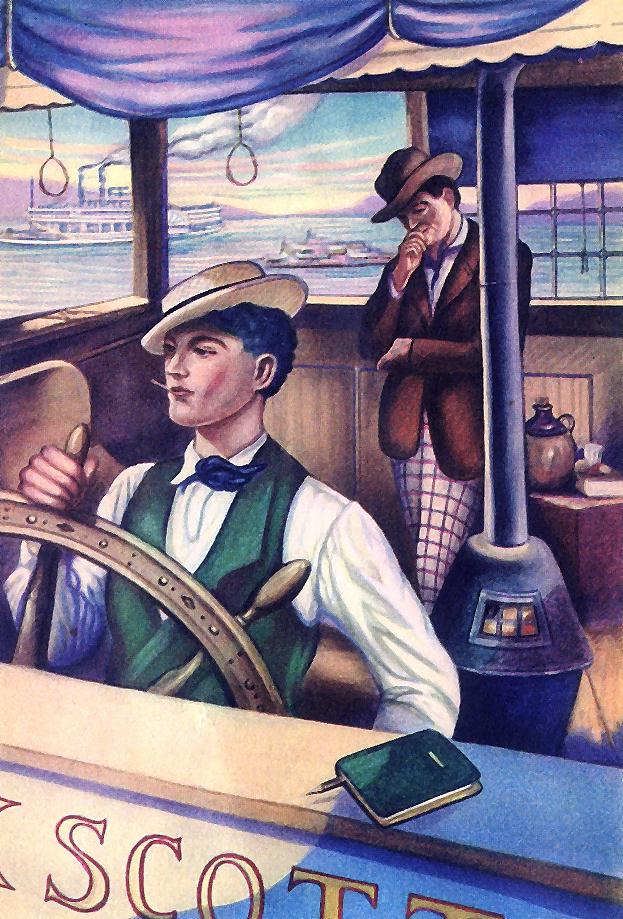
Sam Clemens cub pilot Illustration
Illustration by Walter Stewart for a later edition of Mark Twain's LIFE ON THE MISSISSIPPI picturing cub pilot Sam Clemens at the wheel of the steamboat ALECK SCOTT in the pilot house as Sam's mentor Horace Bixby stands behind him in the background.
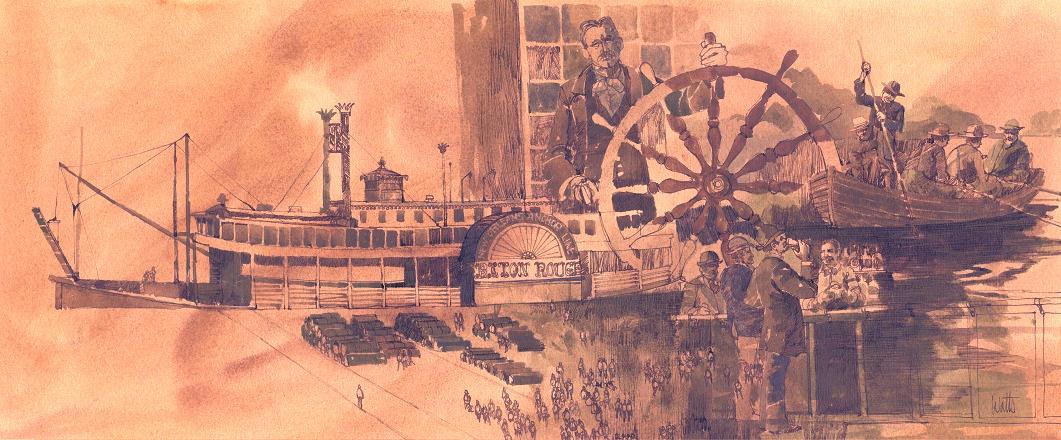
Pen and Ink with Sepia Wash by WATTS based on illustrations from LIFE ON THE MISSISSIPPI
Attached scan of Sketches based on the illustrations in the 1st Edition [1883] of the non-fiction book Life on the Mississippi by Sam Clemens (Mark Twain). The original pen and ink with sepia wash measures 10 x 24 inches on illustration board and signed by "WATTS."
Watts also referred to illustrations from the first editions for the character poses of Tom, Huck, Becky, Aunt Polly and Jim in the other 4 paintings in the "set" which depict scenes from these stories by Clemens: Tom Sawyer, Huckleberry Finn, A Connecticut Yankee in King Arthur's Court and The Celebrated Jumping Frog of Calaveras County.
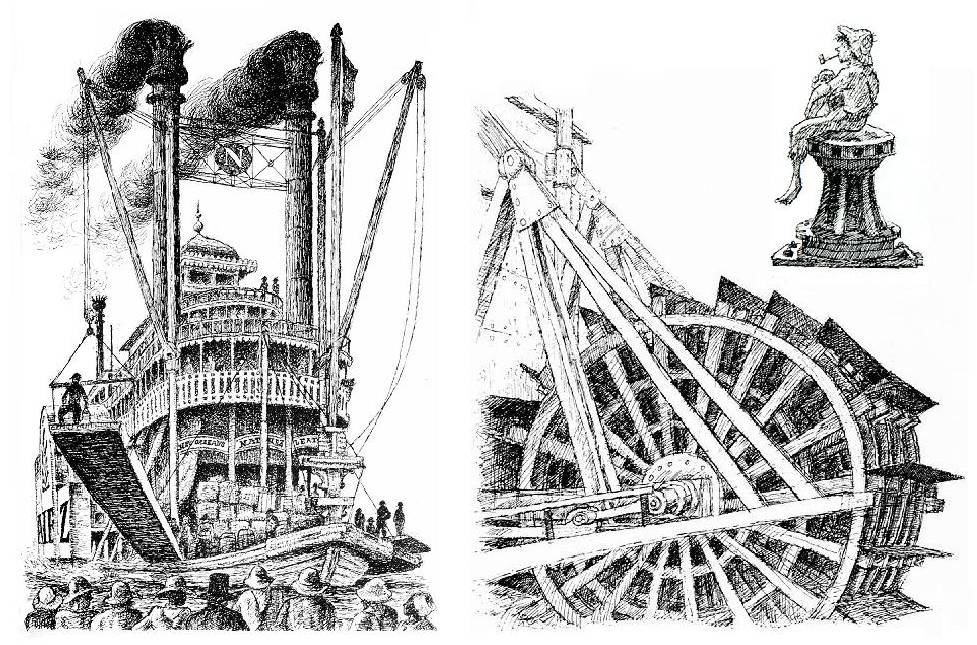

Examples of Danish illustrator Ib Spang Olsen's [1921 - 2012] carefully-researched illustrations for an edition published in Denmark entitled "Livet på Mississippi" (a translation of Mark Twain's "Life on the Mississippi") which was first published by Centrum in 1979.
On the left is Captain Leather's steamer Natchez about to make a landing. Upper right is a boy sitting on a capstan, below him be a drawing apparently based on a photo of the sternwheel of a later-day towboat.
Olsen's rough & ready style is humorous & whimsical, well suited to Sam Clemens' stories of the time he spent on steamboats.
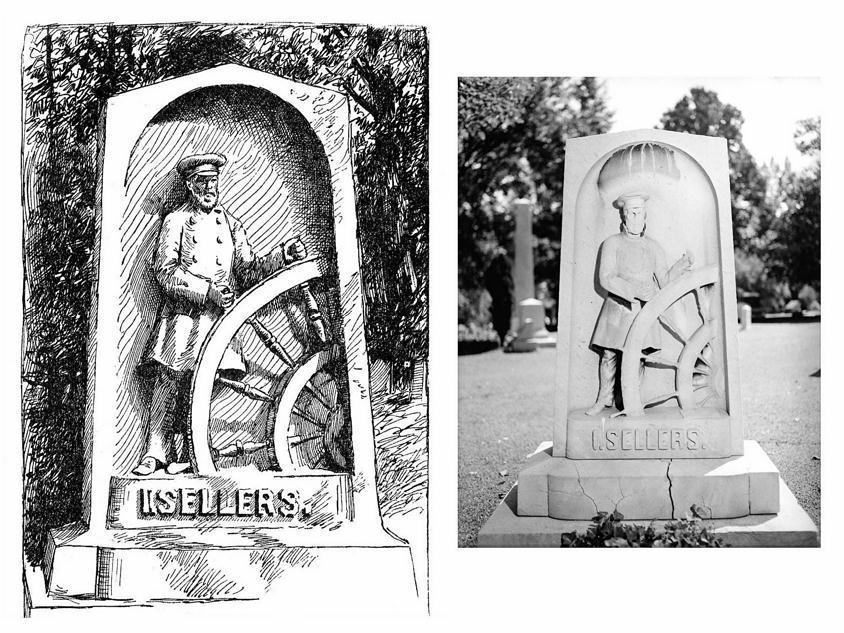
An illustration of Captain Sellers' grave from Mark Twain's LIFE ON THE MISSISSIPPI and a photograph of it taken during the 1930's.
Clemens claimed to have "stolen" the pen name "Mark Twain" from Captain Sellers but no surviving newspapers published in St. Louis or New Orleans during Sellers' lifetime have articles on "River News" that were signed "Mark Twain." Why Clemens would accuse himself of purloining another man's nom de plume if it wasn't true is puzzling although he was prone to invent things in his "non-fiction" and autobiographies to make what he must have assumed "made a better story."
Below are the first and last paragraphs from Chapter 50 of Mark Twain's LIFE ON THE MISSISSIPPI, {1883}. The paragraphs in-between the ones below include more about Sellers' life and Clemens' supposed "borrowing" of the pen name "Mark Twain" from the veteran riverman.
"We had some talk about Captain Isaiah Sellers {1802 - 1864}, now many years dead. He was a fine man, a high-minded man, and greatly respected both ashore and on the river. He was very tall, well built, and handsome; and in his old age-- as I remember him--his hair was as black as an Indian's, and his eye and hand were as strong and steady and his nerve and judgment as firm and clear as anybody's, young or old, among the fraternity of pilots. He was the patriarch of the craft; he had been a keelboat pilot before the day of steamboats; and a steamboat pilot before any other steamboat pilot, still surviving at the time I speak of, had ever turned a wheel. Consequently his brethren held him in the sort of awe in which illustrious survivors of a bygone age are always held by their associates. He knew how he was regarded, and perhaps this fact added some trifle of stiffening to his natural dignity, which had been sufficiently stiff in its original state.
. . . The captain had an honorable pride in his profession and an abiding love for it. He ordered his monument before he died, and kept it near him until he did die. It stands over his grave now, in Bellefontaine cemetery, St. Louis. It is his image, in marble, standing on duty at the pilot wheel; and worthy to stand and confront criticism, for it represents a man who in life would have stayed there till he burned to a cinder, if duty required it."
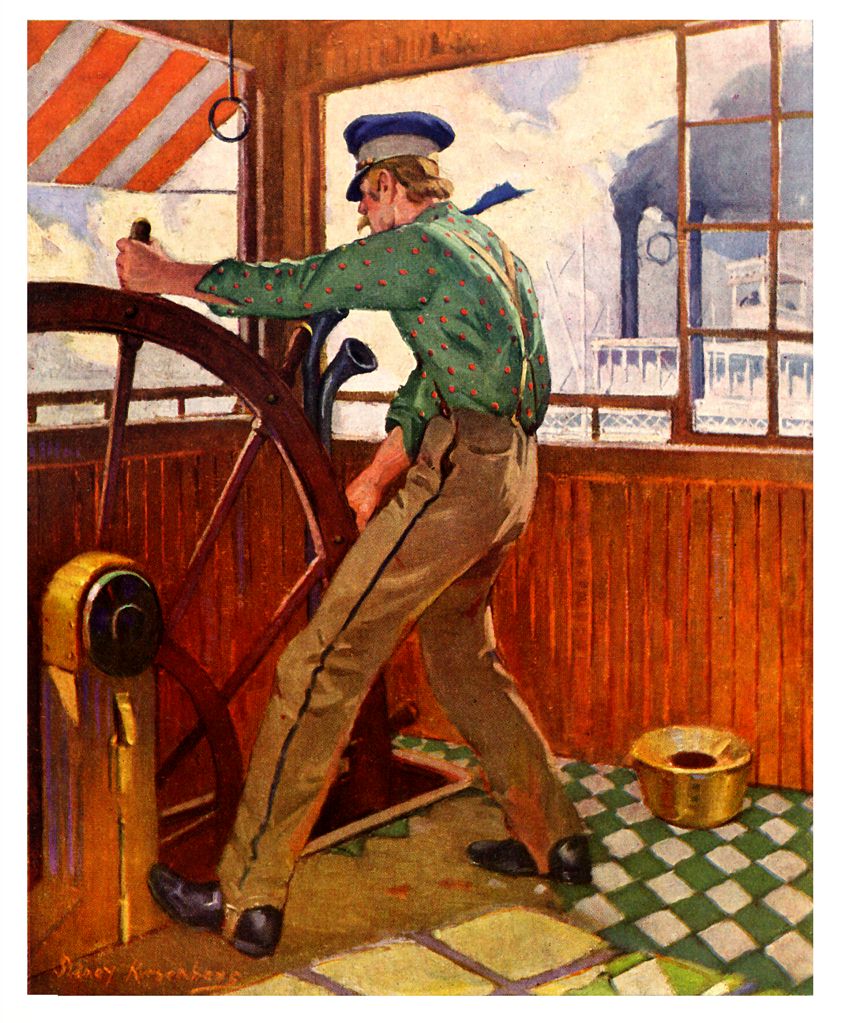
Sidney Riesenberg's illustration of "Mark Twain the riverboat pilot" where you'll see red spots before your eyes on his green shirt. Nice stripe'd awning up front which I haven't seen on a pilot house elsewhere. Cleanest "spittoon" you've ever seen there too.
This eye popper was painted for:
PIONEERS ALL! ACHIEVEMENTS IN ADVENTURE
by Joseph Lewis French
Published by Milton Bradley, 1929
All together nineteen American "pioneers" were given the juvenile biography treatment including Lewis and Clark, Kit Carson, Daniel Boone, John C. Fremont, Charles Lindbergh, and 12 others.
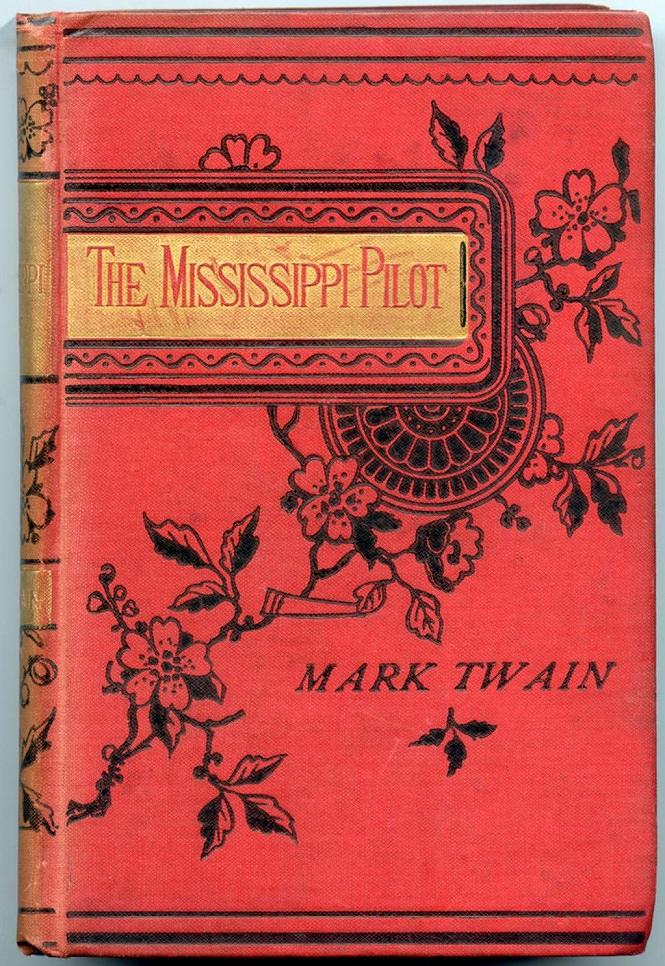
The Mississippi Pilot . . . UK edition of the Old Times/Mississippi memoirs from the Atlantic Monthly
Just acquired from the UK . . . an undated edition of Mark Twain's (Sam Clemens') THE MISSISSIPPI PILOT published by Croome & Co., Bride Street, LONDON.
Having been serialized as OLD TIMES on the MISSISSIPPI in the Atlantic Monthly in 1875 the Canadians pirated that book under the same title but in England they must have given SLC his fair due.
OLD TIMES was Clemens' reminiscence of "learnin' the river" as a "cub pilot" under Horace Bixby and then becoming a licensed pilot on the Mississippi between St. Louis and New Orleans.
Pages 1 - 142 contain Sam's dissertation preceded by the following preface, assuring the reader that it would be "very humorous"; contained "nothing to offend" and assumed that the readers would be men, not women since the reader is referred to as "him":
The following pages contain a very humorous account of the life of a Mississippi Pilot.
Amid his varied experiences, Mr. Clemens, the writer of this book, appears to have studied piloting ; and if our information be correct, he assumed his nom de plume, Mark Twain, from the sounding line in use on the river, the cry 'mark twain' being the depth indicated, as mentioned at page 31.
But the pilot's life, as described by Mark Twain, is not merely a record of adventure. It is full of information; and, under the thick veil of quaintness and American drollery, there lies much practical knowledge and information.
The difficulties of the Mississippi Pilot are no fiction, and while Mark Twain carries us along with him in easy flowing narrative, we are constantly reminded of the danger of the channel and the skill of the pilot himself.
And although 'Mark Twain' does not shrink from some forcible word-painting in his book, there is nothing to offend even the fastidious reader in the pages now offered for his perusal.
THE MISSISSIPPI PILOT: Chapters and page numbers -
I. How I Became a Pilot 1
II. A "Cub" Pilot's Experience ; or, Learning the River 14
III. The Continued Perplexities of Cub Piloting 35
IV. The "Cub " Pilot's Education nearly Completed 55
V. "Sounding." Faculties peculiarly Necessary to a Pilot 74
VI. Official Rank and Dignity of a Pilot. The Rise and Decadence of the Pilots' Association 96
VII. Leaving Port : Racing : Shortening of the River by Cut-offs : A Steamboats Ghost : "Stephen's "Plan of "Resumption" 123
The second half of the book contains Bret Harte's novel MEN OF SANDY BAR followed by 14 of Harte's poems. The Harte portion is paginated from scratch, commencing with 1 and finishing with 162.
No mention of Harte on the front cover but the title page includes Harte's name and title in the same sized fonts under Sam's first place position.
5 x 7/14 x .80 inches thick.
LIFE on the MISSISSIPPI, which included the piloting memoirs from OLD TIMES would be published in 1883 so this MISSISSIPPI PILOT edition was likely published between 1876 when the memoirs were published in the Atlantic and 1882.
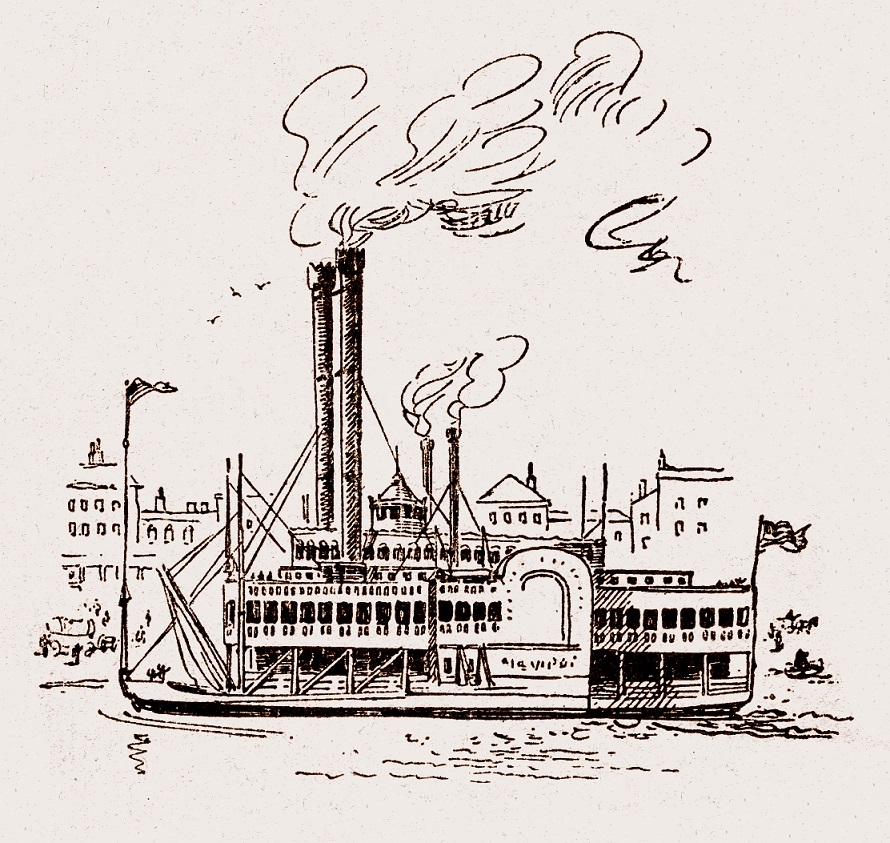
Attached scan of the pen and ink drawing of a steamboat from the center of the front cover of the 1949 German translation of Mark Twain's LIFE ON THE MISSISSIPPI ("LEBEN AUF DEM MISSISSIPPI") by illustrator Heiner Rothfuchs who created the 1860 pictorial map of the Mississippi River for the front fly leaves that I sent previously.
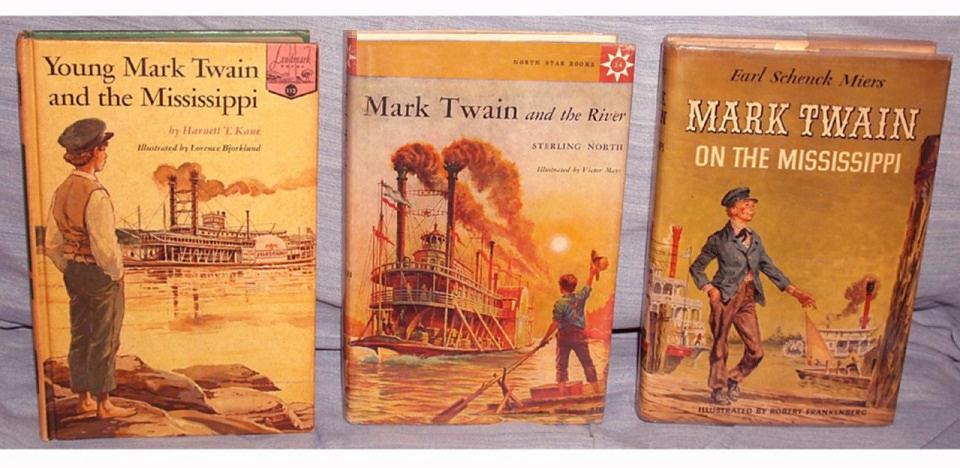
Don't think any of these are in print but each has its merits as far as content and illustrations. You could mention them to teachers when you submit possible lesson plans.
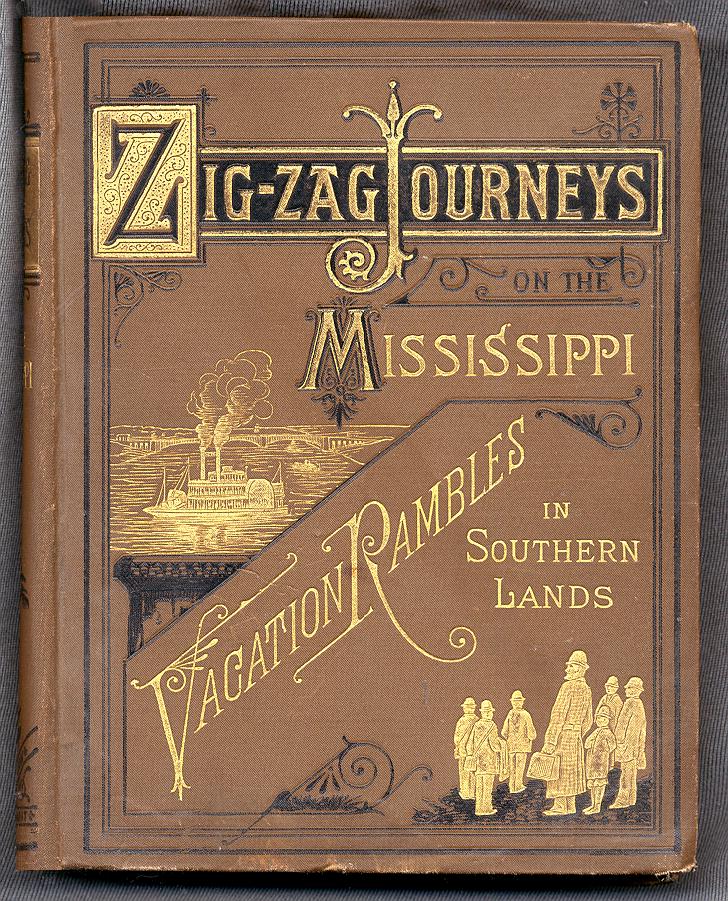
6.80 x 8.40 inch cover of the 14th from the series of 17 "Zig-Zag Journeys" national and International-themed travel books by Hezekiah Butterworth.
I found this copy in a quaint little bookshop in the French Quarter in October 1989.
The illustrations all apparently came from many previously published books, including Mark Twain's LIFE ON THE MISSISSIPPI.
ZIG-ZAG JOURNEYS ON THE MISSISSIPPI; or, From Chicago to the Islands of Discovery 1892
Dana Estes and Co., Publishers, BOSTON
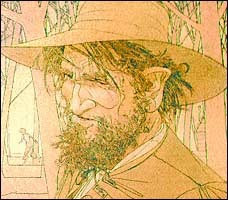
A novel about Huck's Pap: FINN by Jon Clinch
Roberta Hagood who passed on a few years ago at 103 years of age, was born and raised in Northeast Missouri and lived in small towns in the Salt River country and spent many years with her husband Hurley after they retired from West Coast jobs back in Hannibal which was where their siblings were. The Hagoods wrote a series of local history books about Hannibal that I designed dust jackets for.
Roberta had a kind of horror of the Mississippi River, due to an often unpleasant odor of decay that it gives off which can be strongest along the shore and sickens some sensitive people. Jon Clinch's 2007 novel about Huck Finn's "Pap" entitled FINN dwells on the shabby, unsavory and impoverished "river rats" who fished, trapped and stole to eek out their modest living from the river.
Huck Finn's Tormented Father
(David A. Johnson)
washingtonpost.com
Sunday, February 18, 2007
FINN
By Jon Clinch
Random House
287 pp. $23.95
Jon Clinch's haunting first novel not only finds Pap, but in the life of this violent alcoholic it finds the spirit of a nation torn apart by conflicting racial passions. Clinch, who runs an advertising agency in Philadelphia, relies on Twain's details, sometimes borrowing whole scenes and patches of dialogue, but he reorders the characters completely, setting that eager little boy and his unconscious irony far into the background and forcing us to concentrate instead on the anguished man who sired him. Admittedly, part of the dark thrill here is "finding out" the back story that fans of Huckleberry Finn have long wondered about -- Who would ever have had a child with Pap? How did he end up naked and dead on that floating house? -- but this isn't just a creative appendix to an American classic. Clinch reimagines Finn in a strikingly original way, replacing Huck's voice with his own magisterial vision -- one that's nothing short of revelatory.
The novel begins, as such a story must, on the Mississippi River, that incalculably powerful current that's both cradle and grave, giving life across 2,000 miles while carrying away the nation's detritus and death:
"Under a low sun, pursued by fish and mounted by crows and veiled in a loud to such a sad destination as this."
Clinch never absolves him, but Finn comes from a family that would send anybody to the bottle. His mother is a bitter, dissatisfied woman. His father, known to everyone as the Judge, is an unyielding, loveless man who projects an enervating aura of disapproval. Disgusted with Finn's lack of interest in academics, the Judge consigns his son to a shack behind the barn, and there he might have spent the rest of his life, contentedly fishing and hunting and catching odd jobs, had he not come into possession of a young slave named Mary.
This impossibly complicated relationship is the heart of the novel and a testament to Clinch's sensitivity, his willingness to trace the threads of passion no matter where they lead. Naturally, Finn thinks of Mary as his property; he keeps her locked in his shack and orders her to cook and clean for him and eventually sleep with him. But he also appreciates her on a higher level that has no sanction in this racist society.
Finn senses that "there is about her a grace and an ineffable sadness that conspire to retard her movements and make them thereby into something almost musical, transforming every act into a kind of prayer or languorous meditation."
They fall into the habits of an old married couple. Despite "his shameful devotion," "his own untoward preferences in women," Finn eventually defends her with his life -- and even kills for her. "He is faithful to her," Clinch writes, "as to nothing else in this world," and she cares for him in return, without ever losing sight of the precarious nature of her position. When baby Huck comes along, the three of them, though desperately poor and completely outcast, seem genuinely content.
But try as he might, Finn is too weak, too proud and finally too racist to preserve what he later recalls as "the old paradisiacal days in his cabin." And that's the real curse that Clinch describes so powerfully: Finn is fully aware of what he's lost.
"He is tormented to distraction by a kind of desperate unholy vigor," Clinch writes, "by the inescapable conviction that he has abandoned something that he must now restore unto himself."
It's a poignant echo of Huck's description of his father in Huckleberry Finn:
"A body would a thought he was Adam -- he was just all mud."
And what, Clinch asks with unblinking honesty and sympathy, is an angry, remorseful man of mud to do with himself?
In one of the novel's most frightening, incantatory scenes, a grotesque allusion to Tom Sawyer, Finn madly whitewashes the entire interior of his shack -- the walls, the floor, the windows, everything -- desperate to be white, to be clean, to be pure, to cover the blood. But no sooner has it dried than he's drawing on those walls with the grime of his own fingers, creating a vast canvas "of his urge and of his longing and of his despair over the fate of his poor doomed immortal soul."
Here, trapped in a squatter's shack hanging precariously over the river, is the madness of a whole country that will soon tear itself apart in a war over race.
Twain had a grim side, too, of course, but throughout much of his career, he was constrained by writing for the young boys' market. While working on Huckleberry Finn, he wrote in his journal,
"I can't say, 'They cut his head off, or stabbed him, etc. - describe the blood & the agony in his face."
A decade later, already troubled by the depression that would eventually overtake him, he told a friend that he couldn't write all the things he wanted to:
"They would require . . . a pen warmed up in hell."
I don't know where Jon Clinch has been, but with Finn, he's grabbed hold of that searing pen.
Ron Charles is a senior editor of Book World.
© 2007 The Washington Post Company
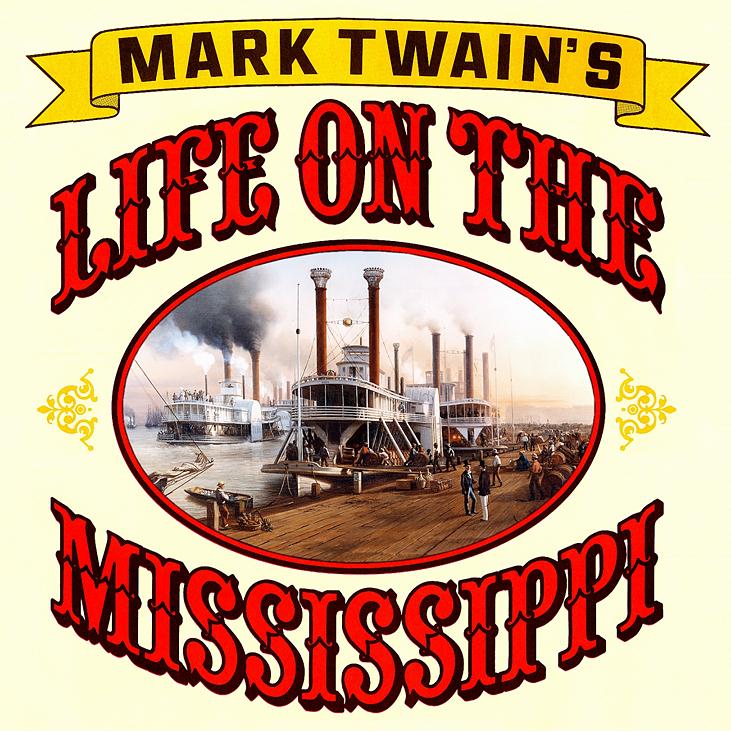
A promotional poster for the PBS LIFE ON THE MISSISSIPPI TV movie in 1980 was issued with photographs of locations in Hannibal, Missouri that were associated with Sam Clemens. I reformatted the lettering and replaced their photo of the JULIA BELLE SWAIN inside the oval frame with a detail from Hippolyte Sebron's 1850 painting of steamboats at New Orleans.

With the exception of images credited to public institutions,
everything on this page is from a private collection.
Please contact Steamboats.com for permission for commercial use.*
All captions provided by Dave Thomson, Steamboats.com primary contributor and historian.
